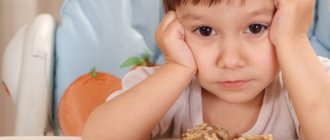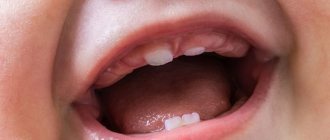One of the most common reasons for visiting pediatric otolaryngologists is inflammation of the tonsils in a child, otherwise known as tonsillitis. Inflammation affects the palates; tonsils are paired lymph glands, often called tonsils. The cause of inflammation of the tonsils in children can be either a viral or bacterial (streptococcal and staphylococcal) infection.
Pediatric ENT doctors at the Miracle Doctor clinic comprehensively assess the child’s condition and develop individual treatment regimens. Experience and the latest equipment allow them to provide high-quality diagnostics and treatment of ENT organs of patients of all ages.
Symptoms
Inflammation of the tonsils in the throat of a child is characterized by the appearance of the following clinical symptoms:
- discomfort in the throat: pain, soreness, rawness;
- increased body temperature (up to 37-38° C);
- appearance of cough;
- sensation of a lump or foreign body in the throat (due to plugs formed on the tonsils);
- general weakness and fatigue, headache;
- white plaque on the tonsils.
Depending on the type and stage of inflammation of the tonsils, the clinical picture may be supplemented by enlargement of the submandibular lymph nodes, redness and swelling of the palatine arches, and the appearance of purulent plugs on the tonsils with a specific unpleasant odor.
.
Air barrier. How does obstructive bronchitis occur?
How does obstructive bronchitis occur?
The respiratory tract in childhood suffers most often compared to other organs. They are affected by various viruses and bacteria, resulting in bronchitis. If thick mucus accumulates in the bronchi and it becomes difficult to breathe, then obstruction develops. Neonatologist Ekaterina Sergeevna MOKEEVA (Nizhny Novgorod) told us about what obstructive bronchitis is and what the most effective methods of treating this disease exist.
The essence of obstruction
Bronchial obstruction is a sudden and severe spasm of the bronchi, which occurs under the influence of infectious or non-infectious factors.
The term “obstruction” means a blockage of the bronchi, which prevents air from entering the lungs freely. Anatomically, obstructive bronchitis differs from normal bronchitis in changes in the entire thickness of the bronchus, which leads to its narrowing, swelling and damage to the entire bronchial tree.
Most often, children under 5 years of age suffer from acute obstructive bronchitis, since their bronchopulmonary system is not yet sufficiently developed. The habit of children breathing through their mouth also plays a big role.
Parents should know that in the nasal passages there are special cilia that, like traps, capture the smallest particles of dust, virus and bacteria. Therefore, if the nasal passages are inoperative and the child’s nose does not breathe, then the risk of contracting bronchitis increases many times over.
Picture of the disease
Obstructive bronchitis begins as a common acute respiratory disease, no different from a cold. The child may develop a cough - in the first days of the illness it is not strong and unobtrusive, a runny nose and a sore throat.
As the cough worsens, there is an increase in body temperature, usually up to 38°C. The cough becomes painful, paroxysmal, does not bring relief (the mucus is very viscous and does not separate) and is most annoying at night. Moreover, a cough with obstructive bronchitis can be whistling, dry, or wet, but even in the latter case, sputum is difficult to clear.
By the patient's breathing, you can understand when bronchial spasm is severe: even without a phonendoscope, wheezing, whistling, shortness of breath, and noise can be heard.
Due to allergization of the body by toxins released during the life of pathological bacteria, effusion occurs through the mucous membranes. The mucous membrane swells and thereby reduces the lumen of the bronchi. This gives a picture of obstruction - narrowing.
Next, an inflammatory process begins in the affected bronchi with the release of histamine. Copious, difficult to separate sputum appears. If this condition is not treated, the obstruction will soon become chronic.
A more complex picture emerges with the development of obstructive bronchitis in children against the background of an allergic reaction. The disease begins with a strong cough, accompanied by a characteristic whistle when inhaling. The child becomes lethargic and inactive, complains of weakness and headache. There may also be pain in the chest along the bronchial tree.
Typically, the hallmark of allergic obstructive bronchitis is the connection between the onset of the disease and any changes in the external environment. For example, you purchased a new carpet, furniture, or you got a pet.
The child may develop shortness of breath - rapid and difficult breathing during physical exertion, and in severe cases, at rest. But unlike cardiac dyspnea, the child does not tend to sleep while sitting or take a vertical position - on the contrary, such children sleep better on their stomach, sometimes hanging their head or placing it below body level - this is due to better discharge of sputum in this position.
Causes of the disease
Risk factors for obstructive bronchitis are:
- frequent acute respiratory viral infections;
- lack of outdoor sports activities;
- sedentary lifestyle;
- tendency to allergies;
- weakened immunity.
Infectious factors that can cause bronchial obstruction include rhinoviruses, adenoviruses, and mycoplasma.
Among non-infectious factors, allergies are the most common. Allergens are found in large quantities in sweets, canned foods, various processed foods and drinks. An allergic reaction can be caused by absolutely any drug or any dietary supplement. Allergies to house dust, animal hair, plant pollen, poplar fluff and much more often develop.
Many parents do not react in any way to the frequent skin rashes that appear in a child after eating new foods. They do not pay attention to the seasonal runny nose, motivating their superficial attitude to this problem by the fact that the symptoms of this condition are minimal, and therefore do not require treatment. This is wrong. In the chronic course of even a mild allergic process, there is a risk of increased sensitization (sensitivity) of the body.
Also, non-infectious factors that contribute to the occurrence of obstruction in a child include passive smoking. Parents should remember that tobacco smoke has an extremely negative effect on the child’s body.
Bronchoobstruction is caused by congenital malformations of the bronchi, impaired immunity due to the characteristics of pregnancy and childbirth of the mother (prematurity, fetal hypoxia, birth injuries and early infections).
We clarify the diagnosis
It is not difficult for an experienced pediatrician to identify obstructive bronchitis; just ask about the symptoms of the disease and listen to the baby’s breathing.
The radiograph sometimes (but not always) shows an increased pulmonary pattern. In a general blood test, ESR may be accelerated. If the cause of the disease was an allergy, the number of eosinophils in the child’s blood will be increased.
Effective treatment
For children under 2 years of age, it is advisable to undergo treatment in a hospital setting.
It is necessary to give a sick child a lot to drink (up to 2 - 3 liters of liquid per day). A hypoallergenic diet is required, and nutrition must be nutritious and age-appropriate.
Any store-bought sweets, sweet carbonated drinks, food products containing preservatives and dyes, including milk cheeses and fruit yoghurts, sausages, and citrus fruits should be completely excluded from your baby’s diet. Also, do not give your child smoked foods, limit the consumption of fatty and fried foods. Of the store-bought fruits, offer only green and yellow ones (red and orange are prohibited) that correspond to the area and time of year. Be careful when including honey and other bee products in your menu.
For obstructive bronchitis, the doctor usually prescribes antispasmodics (no-shpu, papaverine), bronchodilators (salbutamol, berodual), expectorants (lazolvan, ambrobene, acetylcysteine), antihistamines (zodak, zyrtek, tavegil).
If you have a nebulizer at home, you can remove mucus by inhalation using expectorant and bronchodilator solutions. In each specific case, the drugs are selected by the doctor.
Antipyretics should be given only when the body temperature exceeds 38.5°C. The optimal drug is paracetamol. Amidopyrine, antipyrine, phenacetin should not be given to children. It is not recommended to use aspirin and analgin - they can have negative side effects.
If the cough has become dry and occurs in attacks, it is possible to use drugs that affect the cough center, such as libexin. You just need to remember that in this case the sputum will be separated poorly and such drugs must be used in its absence.
Vibration (drainage massage) facilitates the discharge of sputum and can be performed by both the nurse and the parents. In this case, the collar area, back, then the chest, respiratory muscles (sternocleidomastoid, intercostal muscles, abdominal muscles) are massaged.
Antibiotics are prescribed in case of secondary bacterial infection. The following symptoms may indicate this: body temperature is above 39°C, lethargy and loss of appetite are observed, weakness and headaches are expressed, in the general blood test the ESR is accelerated and the content of leukocytes is increased.
It is imperative to rinse the nasopharynx with saline solution, Borjomi, preparations based on sea water and products containing silver.
To restore nasal breathing, vasoconstrictor drugs (tizine, oxymetazoline, etc.) are used. Nasal drops cannot be used for a long time - this can lead to atrophy or hypertrophy of the nasal membrane.
Prevention of exacerbations
The most important thing is to understand the cause of the obstruction and try to eliminate it.
If the disease was caused by a viral infection, then you need to strengthen your immune system and take antiviral drugs prescribed by an immunologist during the cold season.
If the culprit of obstructive bronchitis is an allergy, it is necessary to create hypoallergenic living conditions and, if possible, conduct allergy tests.
Protect a child prone to bronchial obstruction from passive smoking and irritating environmental factors (sudden temperature changes, polluted air, dust and mold in the apartment).
And, of course, the baby needs to be hardened in all available ways: a contrast shower, sufficient time in the fresh air, physical education, swimming in the pool are useful.
Ekaterina QUEEN.
Complications
If inflammation of the tonsils becomes chronic, then exacerbations of the disease occur; 6-7 times a year. The presence of frequent exacerbations indicates a weakened immune response of the child’s body to the presence of infection in the tonsils. Inflammation of the tonsils often leads to the development of complications in the ears, lungs and other organs of the child. In the case of chronic inflammation, the tissue of the tonsils becomes scarred, lacunar plugs appear, and the lacunae themselves become foci for the spread of staphylococcal and streptococcal infections.
.
Treatment
Treatment of inflammation of the tonsils can be either conservative or surgical. Conservative therapy for inflammation of the tonsils includes:
- physiotherapeutic treatment
- prescribing a course of systemic antibiotics;
- symptomatic treatment;
- immunomodulatory and restorative drugs;
- treatment using the Tonsillor device.
- In case of ineffectiveness of conservative treatment and the development of serious complications, a decision is made on surgical intervention. Removal of tonsils for chronic tonsillitis is called tonsillectomy or tonsillotomy.
How is exudative otitis media treated?
Treatment of exudative otitis media always begins with restoring nasal breathing, relieving acute or chronic inflammation of the nasopharynx, and restoring the patency of the auditory tubes. This can be a long process, sometimes up to a month or more, but it is very important to go through this path and achieve recovery. If exudate (liquid that forms as a result of inflammation) is in the tympanic cavity for a long time, more than 1 month, it becomes increasingly thick, viscous, as if “gluing” all the structures of the middle ear together, adhesions form in the tympanic cavity, which leads to persistent hearing loss, development of chronic otitis media. If conservative treatment does not give a stable result, and each cold leads to a relapse of exudative otitis media or it is not possible to restore hearing within 2-3 months, surgical treatment is necessary - removal of the adenoids (adenotomy) , sometimes with partial removal of the tonsils (adenotonsillotomy), shunting, when a small tube is inserted into the eardrum, through which the eardrum is aerated and medications can be administered.
Dear Parents! It is very important to consult an ENT doctor in time so that a common runny nose does not cause serious complications. Even if you think that you have dealt with a runny nose on your own, come and make sure that your child does not have ear problems. After all, normal hearing is the key to a normal quality of life!
Advantages of visiting the Miracle Doctor clinic
When prescribing surgical intervention, along with traditional surgical methods for removing tonsils in children, the Miracle Doctor clinic performs tonsil removal under anesthesia using the cold plasma coblation method, in which a special device with an electrode is used instead of a scalpel. Removing tonsils with a coblator avoids damage to surrounding tissues; the operation is quick and almost bloodless.
Regardless of whether general or local anesthesia is used, highly effective and safe drugs of the latest generation are used. To ensure comfort during the postoperative period, the patient is provided with a separate room in a 24-hour hospital. Pediatric otolaryngologist surgeons at the Miracle Doctor clinic can not only slow down inflammation of the palatine tonsils, but also, in advanced cases, perform surgery using progressive minimally invasive methods.










